Looking for safe but effective exercises to perform at home during your pregnancy? NovaCare Rehabilitation physical therapist Emily Grimm is sharing her favorite exercise routine that can be completed without any equipment from the comfort of your home.
Evidence shows that long-term physical activity during pregnancy can deliver positive outcomes on maternal health, labor, birth and postnatal infant health. Pregnant women who engage in regular exercise using large anti-gravity muscle groups have been shown to have shorter labors, decreased risk of preterm birth or Cesarean section surgeries; even the fetal heart rate responds positively to exercise longer than 10 minutes in duration.
Related: Exercising Pregnant: The Fine Line Between Pushing Too Hard and Doing Too Little
Before we get to our list of exercises, we want to make you aware of some general movements to avoid while exercising during your pregnancy:
- Jerky, bouncy movements
- Abdominal compression
- Inversions
- Prolonged time laying on your back
- Straining the abdominals or pelvic floor
- Vigorous stretching of your adductors
- Extreme asymmetrical lower limb positions (some yoga poses should be avoided)
The at-home exercises listed in this article require minimal or no equipment and will keep your core and pelvic floor muscles strong. These movements can even help reduce some pregnancy-related pain in the lower back, pelvic girdle or hips. These exercises can be a great addition to other light activities like walking and jogging (if comfortable).
As with any exercise regimen, please listen to your body at all times, and do not proceed if you feel pain or discomfort with any exercise.
Start by performing 2-3 sets of 10 reps of the exercises below 2-3 times per week. Emily’s pro tip: to perform a pelvic floor contraction during these exercises, think “holding in the flow of urine then pulling upwards towards your belly button.”

Bridge with Abduction
Place a band around your knees (if you have one), tuck your pelvis as if to flatten your lower back against the floor, squeeze your gluteal muscles and bridge up slightly pushing your knees outward against the band. Hold for 5 seconds and repeat.
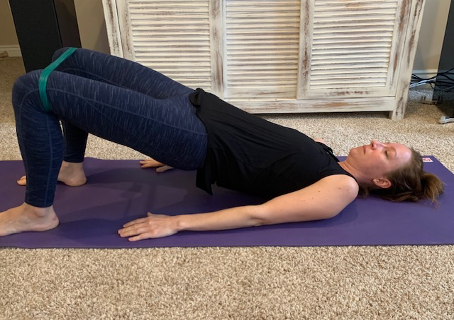
Bridge with Adduction
Place a pillow between your knees. Tuck your pelvis as if to flatten your lower back against the ground, squeeze your gluteals and lift up gently pushing knees into the pillow. Hold for 5 seconds and repeat.

Bird/Dog
Start on hands and knees. Engage your abdominals by pulling in toward your spine (as best you can, difficult to do while pregnant!). Raise your opposite arm and leg, holding 2-3 seconds, then switch.
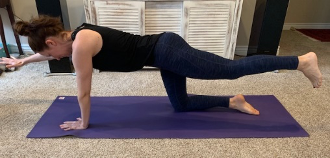
Clams
Lay on your side, place a band around your knees (not required). Keeping your hips stacked, lift your top knee up to rotate your hip out. Repeat movement.
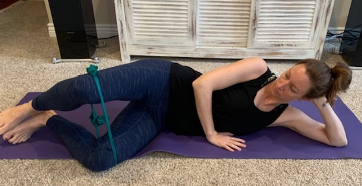
Plank Progression
Try planks against the wall to begin (depending on your tolerance, fitness level, comfort). Make sure to engage your core by pulling your abdomen towards your spine and attempting to perform a pelvic floor contraction. Make sure to breathe. Start with 15 second holds, progressing to 30 seconds, 1 minute as tolerated.
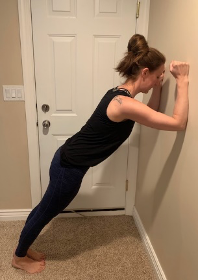
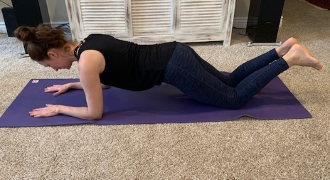

Corrective DRA Curl Up
This exercise is best to perform early in pregnancy or post-partum to reduce abdominal separation.
Place hands on both sides of abdomen gently applying pressure toward your belly button. Perform a pelvic floor contraction, draw abdomen in down toward your spine and curl up as you exhale. Hold 10 seconds, progress toward 30 seconds.
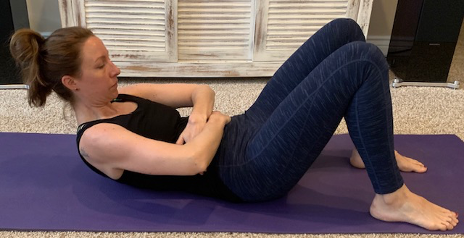
Have a question for Emily or looking for further explanation on these exercises? Give her a call at NovaCare: 773-281-4220. Emily is available for virtual and in-person consults for your needs during this time.

Post written by FFC Contributor and NovaCare Rehabilitation Physical Therapist Emily Grimm.

Emily Grimm is a Doctor of Physical Therapy and Center Manager at NovaCare Rehabilitation in Lakeview. She is an Obstetrics Specialist who enjoys working with pregnant and post-partum women who may be experiencing pain, preparing for or recovering from birth, or looking to maintain or return to a healthy fitness routine. She is also a Certified Manual Therapist with success in treating various other orthopedic conditions.